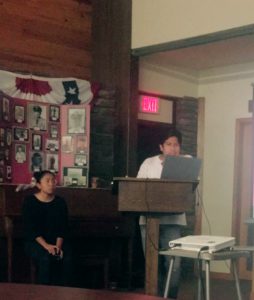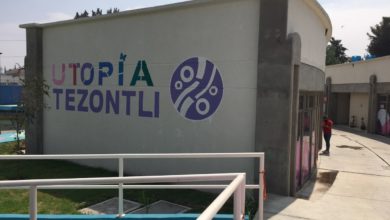 On July 9 in Fayetteville, Arkansas, two local activists, Cynthia Martinez and Fernando Garcia, gave a presentation on the current events of resistance in Oaxaca, Mexico. The presentation, entitled “Oaxaca Resiste,” was the focal point of a fundraising event for a grassroots alternative media effort, Radio Plantón.
On July 9 in Fayetteville, Arkansas, two local activists, Cynthia Martinez and Fernando Garcia, gave a presentation on the current events of resistance in Oaxaca, Mexico. The presentation, entitled “Oaxaca Resiste,” was the focal point of a fundraising event for a grassroots alternative media effort, Radio Plantón.
Martinez’s mother is from Oaxaca, and Garcia is originally from the state in southern Mexico. They had recently been in the area and gave a firsthand account of clashes, in which they had been involved, between protesters and the federal and state police i.
The presentation began with an introduction to the historical and political background to the protests, specifically an explanation of Mexican president Enrique Peña Nieto’s 2013 education reform. This reform, which uses a homogenous examination system for educators (erasing the varied traditions of Indigenous education), forces families to actually pay for the “public” schools outside of tax money and opens the door for full on privatization of the school system in Mexico. Martinez and Garcia made the parallel to what has been happening in schools in Detroit, Chicago, and even Little Rock. In Mexico, the CNTE, a progressive teachers’ union, has taken umbrage to the reform, and after multiple pleas were ignored, CNTE and their supporters took to the streets.
After a basic understanding of the situation, Garcia gave an account of his participation in the stand taken by the protesters in Hacienda Blanca, Oaxaca on June 19. Explaining the barricade system used by the dissident teachers and their supporters, he relayed the methods by which repression from the federal police came upon them. Blocking the streets with what could be found, the goal was to keep the federal police from pushing into Oaxaca city, some 12 km south of Hacienda Blanca. The leaders of the CNTE were located at the state capital.
“At first, we were able to push back the federal police,” he related. Unfortunately, this was only temporary, as federal police in riot gear and assault rifles began pushing in regardless. In an effort to halt this, protesters threw rocks at the police trying keep them at bay. To combat this, helicopters dropped tear gas upon the protesters. “To make things worse,” Garcia recalled, “the state police were coming in at us from Oaxaca city. We were being sandwiched in.” A melee ensued. He was able to escape the the threat of incarceration and possibly torture through the good fortune of being able to take refuge in a local home. In that day of mass protest in both Hacienda Blanca and Nochixtlan, 11 protesters were killed and many more were injured.
The presentation ended with an emphasis on control of information and how the state-run media is used to paint the state as “the good side” and protesters as “bad, greedy teachers.” The media glosses over the actual grievances of the teachers, of the problems of homogeneous standards for teacher exams and the implications that may have on a socio-political level, and paints the reform as a good policy. This, of course, led to why an alternative grassroots media source like Radio Plantón is important. Martinez and Garcia explained the history of Radio Plantón, explaining how instrumental it was even as an organizing tool during Oaxaca protests in 2006. That’s why the event was to fundraise for the media outlet.
A lively question-and-answer followed the presentation. Overall, it was an informative and engaging event, with a large turnout of people genuinely interested in understanding the struggle of the teachers in Oaxaca and its broader meanings. It is events like these that lay an educational foundation for growing political consciousness and internationalist solidarity.






